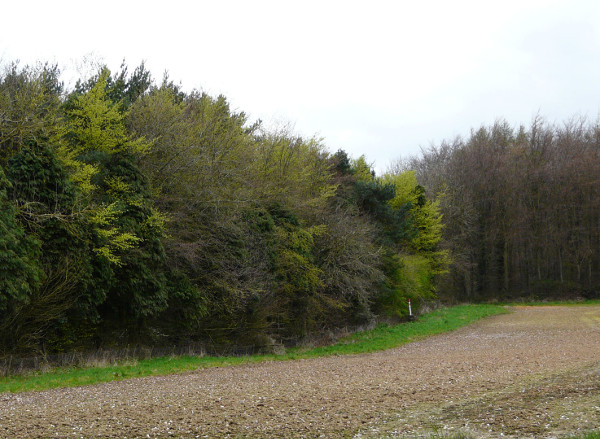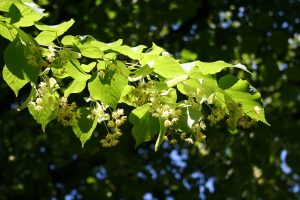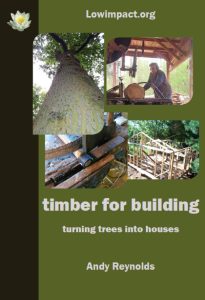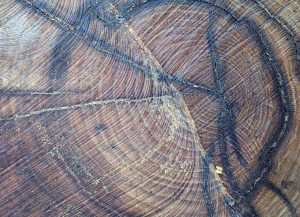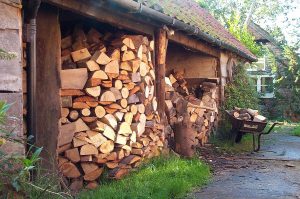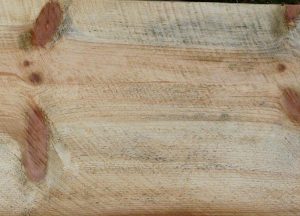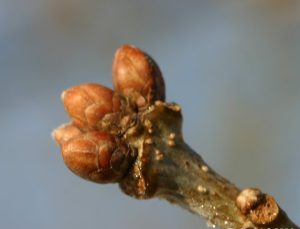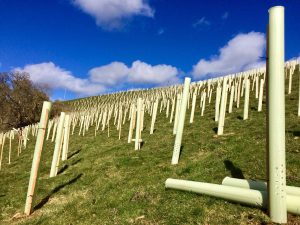The various pressures and threats to UK woodland are ever-increasing. These can include development, climate change or globalisation contributing to the spread of disease, insect and mammalian pests. To put it bluntly, our living environment is offered up as a sacrifice on the altar of the great god of short-term profit. See the photo of a poplar monoculture (below), where all other species were poisoned so that these fast-growing trees could create a quick profit. The market for poplar has since more-or-less disappeared and so makes the whole thing rather laughable if it were not for the impact on the site.

Poplar monoculture.
How do we help ensure that our woodlands don’t die and just disappear? It is here that the diversity of trees and shrubs is important within any woodland, as this has the potential to provide stability and a wide range of habitats. That same diversity can help with general woodland health and conserving its presence within the landscape. Conversely a narrow species range or even a monoculture makes the woodland susceptible to disease or pests. A monoculture can be either broadleaf – as seen in the poplar photo – or conifer, and could include naturally occurring monocultures like ash, where this species makes up 90 percent of the canopy cover. As you are probably aware, ash is now potentially a species on the edge of extreme population decline. So it seems, monoculture of any form and existing for any dogmatic reason is in the end a threat to our environment at large.

Large oak in a broadleaf understorey.
It is important to remember that in most woodland there is some commercial interest that can have a range of practical impacts, varying from intensive ride maintenance, clear felling of compartments to commercial recreational use, and off-grid living. In the vast majority of British woodlands some form of human interaction over the centuries has contributed to the structure as it is now, and so it is not possible to consider the management without including some form of firewood and timber cutting.
It is however the level of these impacts and the fragmented nature of these woods within the landscape, that are underlying factors in their fragile existence. There is nothing wrong (to my way of thinking) with the wish to grow fine timber trees and I can think of many examples where these have been grown in a species mix. The main thing here is the will to do it, and to work with a naturally unfolding woodland rather than treating woodlands like agricultural fields. The photo above shows a large oak surrounded by younger oak and scyamore, showing what can be achieved when the large-scale-harvest-everything-then-replant-to-create-an-even-aged-structure model is rejected. I know that large contractors require volume to make harvesting with machines profitable, and there we have the crux of the matter. It is all a matter of scale, and small-scale can produce a small sustainable income from timber over the years.

Planting / regeneration site with an ash overstorey.
In the planting site photo above, we can see some well-proportioned ash crowns free from damp air in an attempt to reduce the effects of ash dieback. Under this a wide variety of species have been planted with the aim of creating a rich understorey that will produce useful firewood.
Note here that there has been no destruction of the ground flora and soil structure by mulching the brash, in a vain attempt to gain a clean site for planting. The brash has been heaped where it will slowly decay, providing habitat and releasing the embedded carbon and nutrients slowly. You can tell from this comment that I think mulching brash into the woodland floor is very detrimental, as it introduces huge volumes of wood fibre into the soil where all the nitrogen is then used up by bacteria in the process of recycling. This leaves a denuded soil much like the dead soils in the surrounding arable fields.
This method of small-scale woodland regeneration can also apply to mixtures where a previously conifer-rich mixture is continuously thinned and other species (including conifers) are introduced as the light levels allow. The photo is of reasonably large Douglas fir with oak / ash semi-mature understorey, and conifer regeneration to my mind is quite a delight. I must say that the mantra of ‘remove all conifers from woodlands’ is rather short-termist, and removing them before maturity speaks to me of a political theory rather than practical sense.

Large Douglas and broadleaf mix.
In the mid twentieth century an understandable backlash started against the agricultural-like, production-driven attitude to woodland, forestry, and timber, where monoculture was king and volume the only aim. This backlash, primarily against conifers, although useful at the time, as a contributor to modern environmental policy needs considerable editing.
The value of woodlands is greater than the sum of the species diversity and as such, for any woodland to continue to exist, it may mean that the species it contains will change over time, and especially as environmental conditions change.
The traditional view of the species seen in UK woodlands was set out by defining those species that were considered to be present before a set date. This may have been helpful when struggling against full-blown commercial forestry interests, but now considering the threats to woodlands, a narrow list of acceptable species is not appropriate. The climatic changes that are happening, along with new pests and diseases, may wipe out many of the species that we have come to believe are native, and this is already beginning to happen.

Scots pine, oak, ash, sycamore mix after first thinning.
The increase in habitat diversity and structural stability with a mix of species is easily argued if one considers a monoculture of any form against a mix of (say) six species that have silvicultural characteristics suited to the site, aspect and latitude.
The photo above shows a broadleaf / Scots pine mix after the first thinning. All species seem to be growing at a similar rate and this helps with the production of usable timber. I do like Scots pine that is grown well as it is such a nice timber to work with. The large heartwood and the relative stability are helpful, but the tendency to be resinous means that kiln drying needs to be thorough and steady. As always, attention is required with thinning, especially when one species element is more vigorous than another. A broadleaf mix with Norway spruce or western red cedar works well but a delayed thinning of the conifer can often destroy the potential of good form in the broadleaves. Retaining some of the conifer element through the various stages of thinning and planting is an option that does not occur to some tidy-minded people.

Oak and western red cedar group.
So when choosing tree species for new woodland, or a restocking of an area where harvesting or some form of environmental disturbance has taken place, then climate change should be taken into account. Creating a new woodland will require a different mix to that for a replanting site. The exposure and the lack of woodland soil on a new planting site will mean a greater proportion of pioneer species will be needed to quickly gain a foothold – a point commonly missed.
The Forestry Commission is among a number of organisations giving advice on species suitable for tree planting, and the changes in our climate that will have a great effect on temperature, rainfall, and frequency of floods and droughts. Personally, first of all I would consider the silvicultural characteristics of the various species and try to match them to the site, then consider the timber qualities and the end use, and then ask if this mix contributes to all the aspects I have been talking about. It would do well for funded bodies that have interests in woodlands and the associated habitats to widen their view of species diversity.
It is now no longer possible to give a definitive list of acceptable species, but it is important to make sure that species are suitable for the site. The mixture you choose should not include imported plants, as this is where some of our current problems have arisen, but can include non-native species grown in local nurseries. It is important to be definitive about plant sources to reduce the risk of importing further diseases and pest species as our border controls seem to be quite inefficient or are constrained by unhelpful regulation. For myself, I would choose species that will grow well on the specific site, produce usable timber, and contribute to the habitat and woodland stability. I have worked for many years in both the construction and forestry industries and recognise the full value of well-grown timber, having sourced locally-grown and -sawn timber, and kiln dried this for our own stock. I think there is much to be recommended with adding conifer to the mix of species. These will add much-needed shelter in the winter, add a variation to colour in the landscape, a diversity of habitat, and an important local building timber resource. The main image at the top of this article shows a mixed-species woodland edge (broadleaf and conifer) – a comparison is naturally drawn with the monoculture beech plantation beyond.
Andy Reynolds: forester and instructor, practitioner in low-impact living; click here for his YouTube channel and here for his book, Timber for Building.

